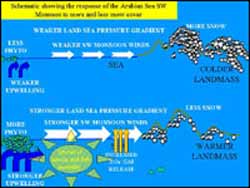NASA study finds snow melt causes large ocean plant blooms

A NASA funded study has found a decline in winter and spring snow cover over Southwest Asia and the Himalayan mountain range is creating conditions for more widespread blooms of ocean plants in the Arabian Sea.
The decrease in snow cover has led to greater differences in both temperature and pressure systems between the Indian subcontinent and the Arabian Sea. The pressure differences generate monsoon winds that mix the ocean water in the Western Arabian Sea. This mixing leads to better growing conditions for tiny, free-floating ocean plants called phytoplankton.
Lead author of the study is Joaquim Goes. He is a senior researcher at the Bigelow Laboratory for Ocean Sciences, West Boothbay Harbor, Maine. Goes and colleagues used satellite observations of ocean color to show phytoplankton concentrations in the Western Arabian Sea have increased by more than 350 percent over the past seven years. The study is in this week’s SCIENCE magazine
When winter and spring snow cover is low over Eurasia, the amount of solar energy reflected back into the atmosphere is less. A decline in the amount of snow cover means less of the sun’s energy goes towards melting of snow and evaporation of wet soil. As a result the land mass heats up more in summer creating a larger temperature difference between the water of the Arabian Sea and the Indian subcontinent landmass.
The temperature difference is responsible for a disparity in pressure over land and sea, creating a low pressure system over the Indian subcontinent and a high pressure system over the Arabian Sea. This difference in pressure causes winds to blow from the Southwest Arabian Sea bringing annual rainfall to the subcontinent from June to September. In the Western Arabian Sea, these winds also cause upwelling of cooler nutrient-rich water, creating ideal conditions for phytoplankton to bloom every year during summer.
Since 1997, a reduction in snow has led to wider temperature differences between the land and ocean during summer. As a consequence, sea surface winds over the Arabian Sea have strengthened leading to more intense upwelling and more widespread blooms of phytoplankton along the coasts of Somalia, Yemen and Oman.
According to Goes, while large blooms of phytoplankton can enhance fisheries, exceptionally large blooms could be detrimental to the ecosystem. Increases in phytoplankton amounts can lead to oxygen depletion in the water column and eventually to a decline in fish populations.
The Arabian Sea hosts one of the world’s largest pools of oxygen-poor water at depths between 200 and 1,000 meters (656 to 3,281 feet). Since the Arabian Sea lacks an opening to the north, the deeper waters are not well ventilated. Also when organic matter produced by phytoplankton breaks down and decomposes, more oxygen gets consumed in the process. An increase in phytoplankton could therefore cause oxygen deficiencies in the Arabian Sea to spread, leading to fish mortality.
Oxygen-depleted waters also provide the perfect environment for the growth of a specialized group of bacteria called denitrifying bacteria. These bacteria convert a nitrogen-based nutrient readily consumable by plants in seawater, called nitrate, into forms of nitrogen that most plants cannot use.
One form of nitrogen that plants cannot consume is nitrous oxide, also known as laughing gas. In the atmosphere, nitrous oxide is 310 times more potent as a greenhouse gas than carbon dioxide. Thus, as very large phytoplankton blooms deplete more oxygen from the water, the creation of nitrous oxide in the Arabian Sea could exacerbate climate change, Goes said.
Media Contact
More Information:
http://www.hq.nasa.govAll latest news from the category: Life Sciences and Chemistry
Articles and reports from the Life Sciences and chemistry area deal with applied and basic research into modern biology, chemistry and human medicine.
Valuable information can be found on a range of life sciences fields including bacteriology, biochemistry, bionics, bioinformatics, biophysics, biotechnology, genetics, geobotany, human biology, marine biology, microbiology, molecular biology, cellular biology, zoology, bioinorganic chemistry, microchemistry and environmental chemistry.
Newest articles
Humans vs Machines—Who’s Better at Recognizing Speech?
Are humans or machines better at recognizing speech? A new study shows that in noisy conditions, current automatic speech recognition (ASR) systems achieve remarkable accuracy and sometimes even surpass human…

Not Lost in Translation: AI Increases Sign Language Recognition Accuracy
Additional data can help differentiate subtle gestures, hand positions, facial expressions The Complexity of Sign Languages Sign languages have been developed by nations around the world to fit the local…

Breaking the Ice: Glacier Melting Alters Arctic Fjord Ecosystems
The regions of the Arctic are particularly vulnerable to climate change. However, there is a lack of comprehensive scientific information about the environmental changes there. Researchers from the Helmholtz Center…



